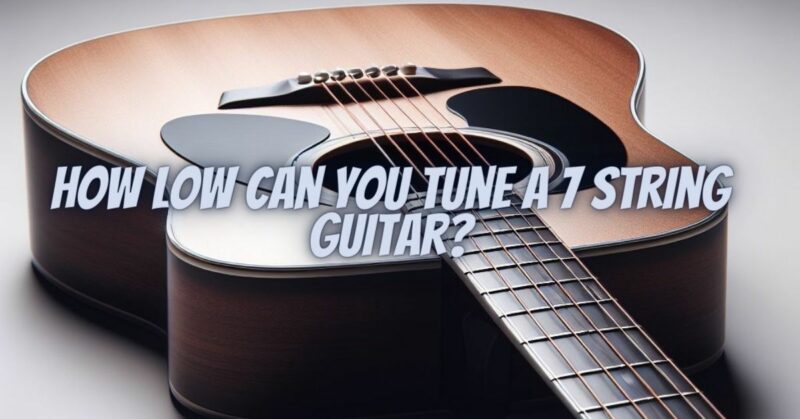The 7-string guitar, with its extended range and added low B string, has been a game-changer in the world of modern guitar playing. This instrument offers guitarists the opportunity to explore lower registers and create heavy, powerful, and innovative music. But just how low can you tune a 7-string guitar? In this article, we will delve into the possibilities and considerations when it comes to tuning a 7-string guitar to achieve the lowest, most thunderous tones.
Understanding the 7-String Guitar
The 7-string guitar features an extra low B string, which is usually tuned to a B1 note, extending the instrument’s range. In standard tuning, the seven strings produce the following pitches from low to high: B1, E2, A2, D3, G3, B3, and E4. This extended range allows for deeper and heavier sounds, making it a popular choice for genres like metal, djent, jazz, and fusion.
Tuning Variations
The low B1 string offers plenty of room for experimentation, and guitarists have explored various tuning options to create unique sounds and adapt to different musical styles. Here are some common tuning variations for the low B string on a 7-string guitar:
- Standard Tuning (BEADGBE): This is the most common tuning for a 7-string guitar. The low B string is tuned to B1, and the rest of the strings follow the standard guitar tuning.
- Drop A (AEADGBE): In this tuning, the low B string is lowered to an A1, giving the guitar a heavier, darker sound. It is frequently used in metal and progressive rock.
- Drop G (GDADGBE): Dropping the low B string to G1 results in a deep, growling tone. This tuning is popular among djent and heavy metal guitarists.
- Baritone (BEADF#BE): The baritone tuning involves raising the low B string to an F#2, making the guitar sound similar to a baritone guitar. It offers a unique tonal quality and is used in various genres, including jazz and experimental music.
- Octave Below Standard (B0EADGBE): For those seeking the deepest, most resonant tones, tuning the low B string to B0 offers an octave below the standard low B1. This tuning is incredibly low and thunderous, commonly used in genres like doom metal and experimental music.
Considerations When Tuning Low
Tuning a 7-string guitar to achieve extremely low frequencies requires some considerations:
- String Gauge: Using heavier gauge strings for the low B string can help maintain tension and intonation when tuning low. Thicker strings are less likely to flop or buzz.
- Scale Length: The scale length of your guitar affects how well it can handle low tunings. Longer scales provide more tension, which can help keep the strings stable at lower frequencies.
- Setup and Action: It’s essential to have your guitar properly set up for low tunings to avoid fret buzz, string rattling, and intonation issues. Adjusting the truss rod, bridge, and action may be necessary.
- Amp and Speaker Considerations: Achieving those subterranean tones also depends on your amplifier and speaker setup. Make sure your equipment can handle the extended low frequencies without distortion or damage.
- Playing Technique: Playing in lower tunings often requires adjusting your technique, especially for maintaining clarity and articulation. Palm muting and note separation become crucial for precision.
The 7-string guitar, with its low B string, opens up a world of possibilities for exploring deeper, heavier, and more resonant tones. Tuning variations such as drop A, drop G, baritone, and even an octave below standard offer guitarists a wide range of sonic landscapes to explore. However, it’s crucial to consider factors like string gauge, scale length, setup, and playing technique when delving into lower tunings.
As guitarists continue to push the limits of their instruments, the question of how low you can tune a 7-string guitar remains open-ended. The answer ultimately depends on your musical vision and the technical aspects of your gear and playing style. Whether you’re creating thunderous riffs in the depths of doom metal or experimenting with innovative sounds in the world of progressive music, the 7-string guitar offers endless possibilities for exploring the lower frequencies of the musical spectrum.


